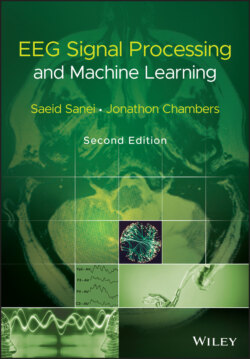Читать книгу EEG Signal Processing and Machine Learning - Saeid Sanei - Страница 23
2.2.1 Conventional Electrode Positioning
ОглавлениеThe International Federation of Societies for Electroencephalography and Clinical neurophysiology has recommended the conventional electrode setting (also called 10–20) for 21 electrodes (excluding the earlobe electrodes) as depicted in Figure 2.3 [14]. Often, the earlobe electrodes called A1 and A2, connected respectively to the left and right earlobes, are used as the reference electrodes. The 10–20 system avoids both eyeball placement and considers some constant distances by using specific anatomic landmarks from which the measurement would be made and then uses 10 or 20% of that specified distance as the electrode interval. The odd electrodes are on the left and the even ones on the right.
For setting a larger number of electrodes using the above conventional system, the rest of the electrodes are placed in between the above electrodes with equidistance between them. For example, C1 is placed between C3 and Cz. Figure 2.4 represents a larger setting for 75 electrodes including the reference electrodes based on the guidelines by the American EEG Society. Extra electrodes are sometimes used for the measurement of EOC, ECG, and EMG of the eyelid and eye surrounding muscles. In some applications such as ERP analysis and brain–computer interfacing a single channel may be used. In such applications, however, the position of the corresponding electrode has to be well determined. For example, C3 and C4 can be used to record, respectively, the right and left finger movement‐related signals for BCI applications. Also, F3, F4, P3, and P4 can be used for recordings of the ERP P300 signals.
Figure 2.3 Conventional 10–20 EEG electrode positions for the placement of 21 electrodes.
Two different modes of recordings namely differential and referential, are used. In the differential mode the two inputs to each differential amplifier are from two electrodes. In referential mode, conversely, one or two reference electrodes are used. Several different reference electrode placements can be found in the literature. Physical references can be used as vertex (Cz), linked ears, linked mastoids, ipsilateral ear, contralateral ear, C7, bipolar references, and tip of the nose [15]. There are also reference‐free recording techniques which actually use a common average reference. The choice of reference may produce topographic distortion if the reference is not relatively neutral. In modern instrumentation, however, the choice of a reference does not play an important role in the measurement [16]. In such systems other references such as FPz, hand, or leg electrodes may be used [17]. The overall setting includes the active electrodes and the references.
In another similar setting called the Maudsley electrode positioning system the conventional 10–20 system has been modified to better capture the signals from epileptic foci in epileptic seizure recordings. The only difference between this system and the 10–20 conventional system is that the outer electrodes are slightly lowered to enable better capturing of the required signals. The advantage of this system over the conventional one is that it provides a more extensive coverage of the lower part of the cerebral convexity, increasing the sensitivity for the recording from basal sub‐temporal structures [18]. Other deviations from the international 10–20 system as used by researchers are found in [19, 20].
Figure 2.4 A diagrammatic representation of 10–20 electrode settings for 75 electrodes including the reference electrodes: (a and b) represent the three‐dimensional measures and (c) indicates a two‐dimensional view of the electrode setup configuration.
In many applications such as brain–computer interfacing (BCI) and study of mental activity, often a small number of electrodes around the movement‐related regions are selected and used from the 10–20 setting system.
Figure 2.5 A typical set of EEG signals during approximately seven seconds of normal adult brain activity.
Figure 2.5 illustrates a typical set of EEG signals during approximately seven seconds of normal adult brain activity.
